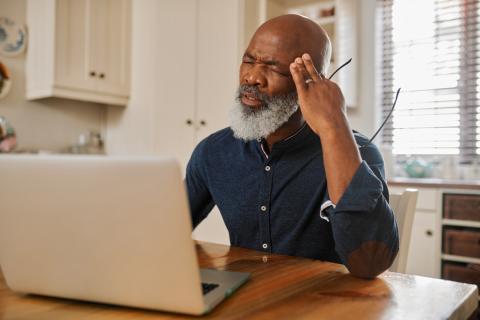Avoiding “Zoom Fatigue”
Natalie Pennington, a University of Nevada Las Vegas communication studies professor, has been studying the effectiveness of various ways friends and family are connecting during the pandemic. She says that while we enjoy seeing each other in a video chat, in certain ways an old-fashioned phone call is more satisfying. She found that phone calls were associated with decreases in stress, loneliness, and relationship maintenance difficulties—yet video chats seemed to have the opposite effect!
Why would that be? “On a theoretical level, you’d think that the richer the medium, the better it is because it can approximate face-to-face communication,” Pennington explained. “But because video chat tries to be face-to-face when it’s not, I think it almost makes you even sadder that you can see the person yet they’re not actually there; because you can’t get those context clues, those things that make us like being in a room with a person.”
Pennington says video chatting also can be more of an energy drain than in-person or phone communications. We feel the need to be totally “on” when we’re video chatting, giving our full attention non-stop, in a rather formal fashion, and without multitasking—in fact, an unnatural way for humans to connect.
Prof. Jeremy Bailenson of Stanford University’s Virtual Human Interaction Lab also has been looking at the challenges of video chatting. He has found four things that are exhausting about video chatting, and offers tips for minimizing what’s been dubbed “Zoom fatigue.”
Video chatting is “in your face.” “Both the amount of eye contact we engage in on video chats, as well as the size of faces on the screen, is unnatural,” Bailenson says. “When someone’s face is that close to ours in real life, our brains interpret it as an intense situation. When you’re using Zoom for many, many hours, you’re in this hyperaroused state.” He suggests minimizing face size on the screen and sitting farther away from the monitor.
Seeing your own face for so long is stressful. Few of us normally spend much time staring into a mirror—but on video calls, we might be looking at ourselves for hours! “In the real world, if somebody was following you around with a mirror constantly—so that while you were talking to people, making decisions, giving feedback, getting feedback, you were seeing yourself in a mirror—that would just be crazy,” says Bailenson. “No one would ever consider that.” He suggests toggling “hide self-view” if that’s an option.
Video chatting anchors us in our chairs. In-person meetings allow us to shift position frequently, perhaps walking around the room or looking down to doodle. But videoconferencing roots us in the same spot. It’s physically uncomfortable—and, says Bailenson, this unnatural stillness even makes it harder to think and remember things. He suggests sitting farther from your camera and turning your video off every so often so you can move around.
We miss subtle communication cues. Communicating in person, we rely more heavily than we might realize on body language, facial cues, and gestures. Video chatting makes that much harder. “You’ve got to make sure that your head is framed within the center of the video. If you want to show someone that you are agreeing with them, you have to do an exaggerated nod or put your thumbs up,” says Bailenson. “That adds cognitive load as you’re using mental calories in order to communicate.” Turning off the camera can help, or periodically turning away from the screen.
This is all a work in progress, and we’re part of the experiment!
The researchers predict that companies, platform designers, and individuals will gradually adjust these communication technologies. Humans have been here before, they say. “When we first had elevators, we didn’t know whether we should stare at each other or not in that space. More recently, ridesharing has brought up questions about whether you talk to the driver or not, or whether to get in the back seat or the passenger seat,” says Jeff Hancock, director of the Stanford Social Media Lab, who is working with Bailenson on this research. “We had to evolve ways to make it work for us. We’re in that era now with videoconferencing.”
Meanwhile, advises UNLV’s Pennington, mix up your communication methods as much as you can. Get on the phone, text, send an email. And of course, we should all get our vaccines as soon as possible so in-person gatherings can happen again!
